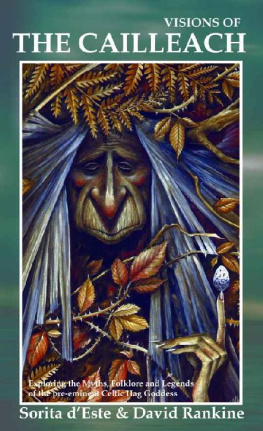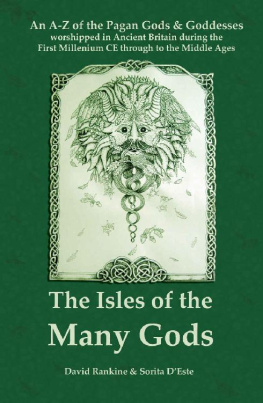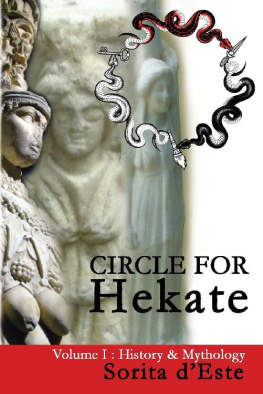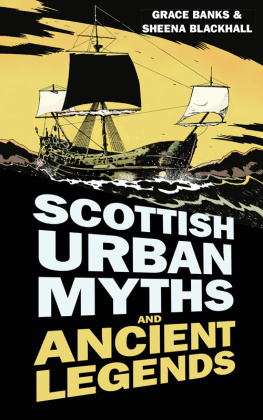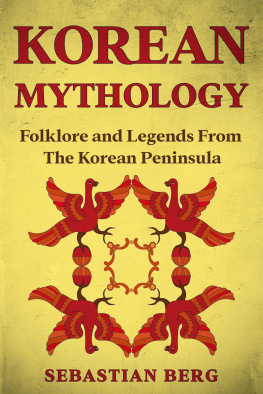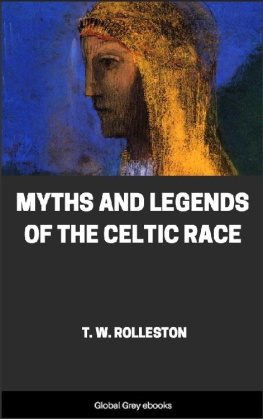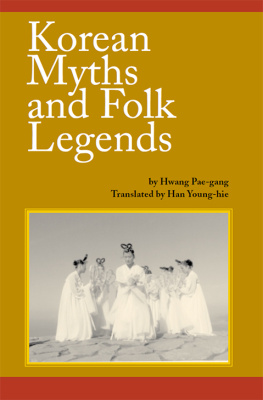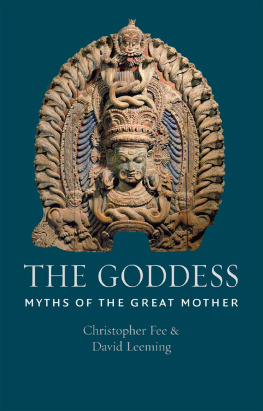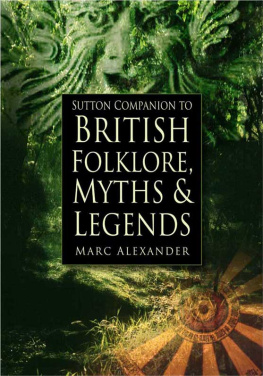VISIONS OF THE CAILLEACH
Exploring the Myths, Folklore and Legends of the pre-eminent Celtic Hag Goddess
Sorita dEste & David Rankine
Published by Avalonia
www.avaloniabooks.co.uk
Determined now her tomb to build,
Her ample skirt with stones she filled,
And dropped a heap on Carron-more;
Then stepped one thousand yards to Loar,
And dropped another goodly heap;
And then with one prodigious leap,
Gained carrion-beg; and on its height
Displayed the wonders of her might.
Jonathan Swift (1667 1745)
BM Avalonia
London
WC1N 3XX
England, UK
www.avaloniabooks.co.uk
VISIONS OF THE CAILLEACH
Copyright Sorita and David Rankine 2008
Print Edition - ISBN 978-1-905297-24-5
Kindle Edition ISBN 978-1-905297-60-3
First Edition, 25 March 2009
Design by Satori
Cover Art Old Woman in the Hedge Marc Potts
All rights reserved. No part of this publication may be reproduced or utilized in any form or by any means, electronic or mechanical, including photocopying, microfilm, recording, or by any information storage and retrieval system, or used in another book, without written permission from the authors.

Old Woman in the Hedge, by Marc Potts
For more information about this visionary artist, visit his website:
www.marcpotts.com
This book is dedicated to our grandmothers.
CONTENTS
Introduction
CHAPTER 1
Origins Set in Stone
The European Origins of the Cailleach
From Spain to Ireland
A Maltese Origin?
The Irish Manuscripts
Name Connections
Goddess or Spirit?
The Different Names of the Cailleach
The Possibility of a Priestess Cult
CHAPTER 2
Earth Shaper
1. The Cailleach in Scotland
2. The Cailleach in Ireland
3. The Cailleach in England
4. The Cailleach in Wales
5. The Cailleach on the Isle of Man
6. The Cailleach in Jersey
7. The Cailleach in Brittany
8. The Cailleach in Norway
CHAPTER 3
Water Witch
1. Predicting the Weather
2. The Cailleach in the Carmina Gadelica
3. Summoning the Water
HAPTER 4
Crone of Winter
1. Winter Customs
2. The Cailleach and Bride
3. The Woman of the Mist
CHAPTER 5
Oldest Spirit
1. The Cally-Berry
2. The Cold May-day Monday
3. The Cailleach Bharthach and the Walker
4. The Cailleach Barras Box
5. Never Ask A Woman Her Age
CHAPTER 6
Lady of the Beasts
1. The Lucky Poachers
2. The Cailleach and the Stupid Deer
3. The Cailleachs Song
4. The Story of Mongan
5. The Old Woman Outwits the Devil
6. The Cailleach Ends the Viking Age
7. The mark left by Cailleach Barra
CHAPTER 7
Shapeshifter
1. The Cailleach Bheur and Loch B (I)
2. The Cailleach Bheur and Loch B (II)
3. Thomas the Rhymer
CHAPTER 8
Bestower of Sovereignty
1. Princess Beara
2. Niall of the Nine Hostages
3. The Adventure of Daires Sons
4. The Daughter of the King under the Waves
CHAPTER 9
Seer & Foreteller of Doom
1. The Caillagh ny Gueshag
2. The Golden Apples of Lough-Erne
3. Foreteller of Doom
CHAPTER 10
Malevolent Cailleach
1. The Gyre Carling
2. The Cailleach of Gleann na mBiorach and the Black Bull
3. The Cailleach Bharthach and Donnchadh Mr Mac Mnais
4. The Cailleach Mhore of Cilbrick
5. The Heron of Lock a-na-Cailleach
CHAPTER 11
Possible Cailleach derivatives
1. Black Annis
2. Glaistig
3. Juan White
4. Mala Lia
5. Muilidheartach
6. Nicneven
7. St Bronagh
Bibliography
INTRODUCTION
The Cailleach is one of the most intriguing and significant figures in British folklore. Some tales portray her as a benevolent and primal giantess from the dawn of time who shaped the land and controlled the forces of nature, others as the harsh spirit of winter. Occasionally there are hints that she may represent the survival of an early sovereignty bestowing earth goddess, or an ancient nature-based priestess cult. In the last twelve hundred years the Christian overlay has both demonised and canonised her.
Although the stories of the Cailleach are essentially British, her origins are not. Exploring the earliest literary references to the Cailleach takes us to the classics of ancient Greece and Rome. References in writings by Herodotus, Strabo and Pliny suggest her worship as a Celtic tutelary goddess on the Iberian peninsula of Spain two and a half thousand years ago.
Moving beyond literature and focusing on the similarities in motifs, such as her giant size and stone-carrying, leads us to Neolithic Malta. There are distinct similarities between the Cailleach and the Maltese giantess Sansuna, credited by legend with building the Ggantija temples on the island of Gozo. These impressive buildings are the oldest religious structures in the world, predating monuments like the Pyramids and Stonehenge.
From such ancient Mediterranean origins, the Cailleach migrated with the Celts from Spain to Ireland, and on to Scotland and the Isle of Man. It is possible that her worship and stories also spread into the rest of Britain, hinted at in local folklore and place names. Thus we find possible echoes of her presence in England, Wales, and Jersey. The continental connection is also reinforced in shared motifs found in Brittany (France) and Scandinavia.
More than any other figure in Celtic or British myth, the Cailleach represents the cumulative power of time. Her great age is a common theme in many of the tales about her, and as a result she has almost always been seen as a hag or crone (a meaning of her name). Her earth-shaping ability, through accidental placement of great stones expresses a mythic explanation for processes which take millions of years. The deliberate placement of stones is frequently tied in with Neolithic burial chambers, hinting at the survival of a cult from the distant past.
The Cailleach also has strong associations with both the weather and water, being viewed as the goddess of the harsh winter months. In this role she has been linked in literature and legend to the Celtic maiden goddess Bride, sometimes as polar opposite and at other times as being dual manifestations of the same goddess. The extent of her power was made clear when she exercised her control over the forces of nature, which made her a significant figure in local folklore.
The Cailleach was also particularly connected with animals in the role of Lady of the Beasts. In Ireland her favoured animal was the cow and in Scotland her particular animal was the deer. She was known to keep herds of her favourite animals and protect them from hunters, who petitioned her for assistance to be successful in their hunt.
A possibility that must be considered is whether some of the Cailleach tales actually relate to a priestess cult. This process of apotheosis of mythical or historical figures, with their actions assimilated into a divine cult, would blur the boundaries between the Cailleach and her priestesses, were this to be the case. The existence of such a cult is not a new idea, as it was suggested in 1932 by J.G. Mackay in his The Deer-Cult and the Deer-Goddess Cult of the Ancient Caledonians . We have found literary references in records from the last two centuries which seem to substantiate the idea of a Cailleach priestess cult of wise women. However, as is often the case these hints ask more questions than they answer, leaving the reader to make up their own mind.
Next page
